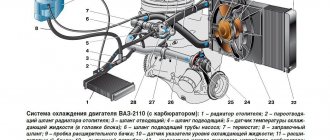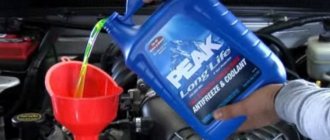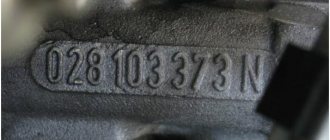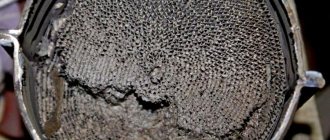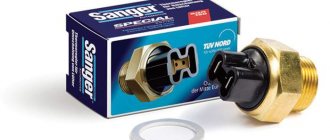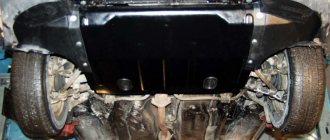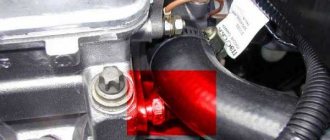Save useful pages!
Antifreeze for Lada Priora
In 2007, budget LADA Priora cars produced by the automobile manufacturer rolled off the production lines. Today there are different versions of this car with increased comfort and new functions. Antifreeze replacement on Priora should occur every seventy-five thousand kilometers.
It is very important to choose the right liquid
. which will fit this car, and then for a long time there will be no comments or complaints.
Company recommendations
Lada Priora
- a machine that is quite unpretentious in maintenance, with a good and reliable engine, resistant to corrosion. Manufacturers managed to remove all design flaws, improve safety, modernize the car's driving performance and improve sound insulation.
What antifreeze to use:
- cool steam standard;
cool steam premium;
If antifreeze leaks on a Priora, you need to find out the problems and causes of the leak.
If antifreeze escapes through the connections, this can be corrected by tightening the clamps. You can also install an additional clamp or replace the old one. If the pump fails, diagnosis is necessary by removing the belt cover. If it goes into the oil system, the oil level rises and repairs are necessary. And when it goes into the cylinders, steam appears from the exhaust pipe, which also leads to repairs. You also need to know how to drain antifreeze from a Priora, observing the necessary conditions. Then it will be easy and feasible for any driver to do. Extreme caution and coordinated actions in the process of such work are recommended.
Replacing the fluid yourself:
- drain antifreeze from the system;
- add new fluid;
- remove air.
Coolant quantity – 7.82 liters
as directed by technical support for normal cooling operation. In some cases, six liters of antifreeze will be enough.
After installing the machine on a flat surface, it takes time for the engine to cool down. Then you need to remove the plastic protection by unscrewing the two fixing clips on the sides and unscrew the cap on the expansion tank. Place a container under the vehicle and drain the liquid by unscrewing the cap on the cylinder block. We also unscrew the protective plug under the radiator and the antifreeze flows out. An important recommendation is to close the existing plugs when the drainage is complete, and you can begin to replace the substance.
Antifreeze
The cooling system is filled year-round with a mixture of water and antifreeze with an anti-corrosion additive from the VW/SEAT concern.
This mixture prevents freezing and corrosion of the cooling system, salt deposits and, in addition, increases the boiling point of the coolant. In the circulation circuit, as a result of the expansion of the liquid when heated, increased pressure is created, which also contributes to an increase in the boiling point of the coolant. The pressure is limited by a valve located in the expansion tank cap, which opens at a pressure of 1.4 - 1.6 bar. For the engine cooling system to function flawlessly, a high boiling point of the coolant is required. If the boiling point is too low, vapor locks can form, causing poor engine cooling. Therefore, the cooling system must be filled with a mixture of water and antifreeze all year round. It is necessary to use antifreeze G12 Plus (purple color, exact designation G 012 A8F) or another con, for example, Glysantin-Alu-Protect-Premium/G30.
If the cooling system is filled with a mixture containing G12 antifreeze (red, exact designation G 012 A8D), then red G12 antifreeze or another con, for example, Glysantin-Alu-Protect/G30, can also be used to replenish the coolant level. Note: G12 purple can be mixed with G12 red.
Caution: Do not mix red G12 antifreeze with the older green G11 antifreeze, as this can cause severe engine damage. The coolant is brown (the result of mixing antifreeze G12 and G11), replace it immediately.
Note: If a liquid with an antifreeze additive of the wrong specification accidentally ends up in the cooling system, the system must be flushed. To do this, all liquid from the cooling system should be completely drained and the system filled with clean water. Leave the engine idling for two minutes. Drain the water again and blow out the system from the side of the expansion tank with compressed air to completely empty it. Close the drain plug and fill the cooling system with a mixture of water and G12-Plus antifreeze.
Attention: To replenish the cooling system (also in the warm season), only use a mixture of G12-Plus (purple) with soft, clean water. The proportion of antifreeze, also in summer, should not be lower than 40%. Therefore, when refilling the cooling system Antifreeze should always be added to water.
In our latitudes, the coolant should provide protection against freezing down to -25 °C, or even better - down to -35 °C. The proportion of antifreeze should not exceed 60% (antifreeze protection of the coolant down to -40 °C), otherwise the antifreeze protection and cooling effect of the liquid are reduced. Note: depending on the vehicle equipment, the amount of coolant added may differ slightly from the values indicated in the table
Ratio of coolant components in liters
Replacing the cooling fluid is a responsible task. Before starting the procedure, you should study the operating rules in detail so as not to get burned. Antifreeze for Priora is poured at certain intervals, observing the standards. It is recommended to replace it every sixty thousand kilometers. Some people prefer to do this once every two years.
Airlock
The design of the SOD on the Priora is made in such a way that the air plug in it is squeezed out independently by the system itself. When replacing antifreeze, the resulting air lock will come out of the system on its own when the car warms up to operating temperature and the thermostat opens to a large circle through the main radiator.
Therefore, all the myths about the airlock on the Prior are a bluff!
You should pay attention to the expansion tank plug, it must be in good working order, the pressure relief valve must function properly. Otherwise, the air lock will not be able to escape.
How many liters of antifreeze are in Priora?
It is believed that cooling liquid must be poured into a Priora 16 with a valve system every five years. It is designed to reduce the engine temperature while driving to avoid overheating.
It is worth replacing on time. If this is not done, antifreeze decomposition products will be deposited on the metal parts of the engine. They are incompatible with the operation of the structure. The device runs the risk of wearing out in a short period of time. It is also possible that the cooling fluid may overheat. The consequences of this can be unpleasant:
- reduction in engine power;
- reduction in equipment service life;
- high fuel consumption.
When should you replace?
The frequency of fluid replacement in Priora models that were released after 2011 is approximately seventy-five thousand kilometers. After this period, antifreeze loses its functional properties. This is only true for the product provided by the original manufacturer. If you use Antifreeze, it will last half as long.
The need to replace the coolant can be determined by the following symptoms:
- the appearance of dirt, uncharacteristic marks, lumps of thickened liquid;
- antifreeze has begun to leak out - it can be replenished, but if you do not know the exact brand, it is recommended to replace it;
- there are deposits and dirty traces in the container, which indicates the need for an urgent replacement of the fluid, which has lost its performance properties;
- under the hood foam appears in the reservoir intended for storing fluid;
- reduction in the quality of operation of the air heating stove;
- The motor heats up at a high speed.
Mixing
Often people on forums wonder if it is possible to mix coolants. There is only one answer to this question - NO! Never mix different coolants, especially antifreeze and antifreeze. All these liquids have different chemical formulas and a reaction can occur between them under the influence of high temperature.
Consequences of mixing
It is allowed to mix antifreeze of different brands, but of the same colors.
How to choose a coolant?
Answering the question of what antifreeze to use in Priora, the manufacturer did not provide a large assortment to its users. It is best to use the Felix-40 cooler. You can use other brands, but this is not recommended. The engine system may wear out in a shorter period of time. As a result, you will have to contact the service for global repairs and replacement of parts.
To find out what kind of antifreeze your car uses, look under the hood. There should be a barrel with a sticker next to the fuel compartment.
If you are using antifreeze from another manufacturer, it is recommended to study its characteristics. It must meet international quality standards.
How to check the fluid level and how much will be enough?
To determine how many liters of coolant are needed to fill the tank, carefully read the vehicle's owner's manual. You will need approximately 7.8 liters. Some car owners prefer to fill a little less - 6 liters.
You can check the antifreeze level in the tank even on a cold engine. To do this, lift the hood lid. You will see a tank. There are two marks on it with a maximum and a minimum value. The fluid level must be within these marks.
If there are no recognition symbols on the tank itself, look for them nearby. There should be a scale that indicates how much antifreeze is in the tank on a Priora with 16 valves. For the engine to operate properly, the level of cooling fluid must remain stable.
Preparatory stage
Before you start, you should do the following:
- choose and buy a suitable cooler;
- stock up on a new cover mount in case the old one is damaged;
- take the wrench;
- find a container where you will send the waste liquid;
- buy rags.
Algorithm of actions
To replace antifreeze in Priora, follow the instructions:
- Send the car to a garage with plenty of free space to work on. Cool down the engine. All actions must be performed on a cold engine system.
- Get rid of high blood pressure. Open the cap of the reservoir containing the antifreeze. If the engine is hot, fluid may splash out. Use a cloth and gloves for protection.
- Remove the protection that is installed on the propulsion system. Unscrew the bolts on the mount. The latches do not need to be removed. They will not interfere with the process.
- If a transmission with cables is installed, it must be removed. To do this, disconnect power from the battery. Remove the protective coating with a wrench.
- Now you need to drain the entire volume of liquid. To do this, unscrew the fixing cap. Place a container below where the waste material will be drained. Wait until all the refrigerant has left the tank. Assess the condition of the latch. If signs of wear are noticeable, replacement is recommended.
- If there are any cloudy traces in the coolant, it is recommended to flush all the channels in the car. To do this, add purified water. Add citric acid or vinegar to remove any remaining dirt. Flush the system until the water runs clear. Only after this can you fill the coolant into the tank.
- Assess the condition of the hoses. If they are worn out, replace them.
- Using a hose, pour new fluid into the container. Avoid high internal pressure.
- Refrigerant is added until the tank is filled to the optimum level.
- All disassembled parts are reassembled in reverse order.
- Start the engine and take it for a test drive. After this, check if all systems are normal.
A few quotes from a physics course
No, we will not sprinkle in formulas and laws, recall Carnot cycles and calculate efficiency using the ABC book. There is simply one figure that will convince even a camel that the coolant in the engine is no less important than engine oil.
If we take an average engine with a power of 100 kW, then according to all the laws of thermodynamics, this figure indicates the positive work that the motor transmits to the drive wheels. A modern tuned motor cannot produce more than 30% efficiency, hence the rated power of our motor is 333 kW. In other words, the engine burns just enough fuel to produce 333 kW. At the output we get only 100. Where the remaining 233 went is quite clear - they turned into heat. The enormous amount of heat that the coolant removes from the engine into the atmosphere.
Why is liquid leaking out?
If there is a constant decrease in the level of antifreeze in the tank, then there is a leak somewhere. Every detail must be examined to quickly identify and repair damage.
What happens if it is too late to replace?
Coolant loses its properties over time. Every year the cooling system will work worse and worse. If you do not change antifreeze on time, you risk the following:
- The engine will heat up faster. If it constantly operates at elevated temperatures, the system risks breaking down quickly.
- The liquid will freeze in the tank. As a result, you will not be able to start your car in winter.
- Blood pressure may increase. Because of this, antifreeze will begin to leak.
Second way:
- We warm up the engine a little so that the pressure in the cooling system increases slightly, and then turn it off.
- Without removing the coolant tank cap, disconnect the pipe from the throttle body
. - After antifreeze or antifreeze
, immediately put the coupler in its place and tighten it with a clamp.
Attention ! Be careful as the coolant being drained may be very hot at this point.
Replacing antifreeze on Lada Priora
Antifreeze is replaced in Lada Priora cars every 75,000 km, or after 5 years of operation. It all depends on which limit comes faster. A second replacement is required after 40,000 km, or two years. During maintenance, monitor the color of the coolant. If it changes color to a reddish color, replace the antifreeze, because this indicates a deterioration in the quality of additives and coolant characteristics.
What antifreeze is better to pour into Priora
The car's cooling system requires 7.84 liters of antifreeze, which is worth considering before replacing. For all engines of VAZ cars, including Lada Priora, the use of the following antifreezes is recommended:
- TC-Felix.
- Cool Stream Standard or Premium.
- G-Energy Antefreeze.
- Syntek.
- Antifreeze G-48 and others.
All recommended coolants can be found in the instruction manual for the Lada Priora.
Replacement process
To change antifreeze on a VAZ 2170, prepare the necessary tool - a Phillips screwdriver, the required volume of coolant (buy one 10 liter canister or two 5 liter canisters), a key for “thirteen”, an empty container for draining the old fluid, as well as a clean rag.
Before draining antifreeze from the system, place the car on a lift or inspection hole. Then proceed like this:
- Open the expansion tank.
- Remove the mudguard from the engine. If you don’t want to remove the protection, you don’t have to do this. But in such a situation, it is worth taking a number of actions to avoid drips. If nothing is done, then, during the draining process, the liquid will hit the crankcase protection and splash around.
- Place an empty container under the engine in a place where the old antifreeze will approximately drain.
- Open the drain hole on the cylinder block. As soon as the coolant is drained, wipe any marks from the engine surface.
- Place the container under the radiator, then open the drain hole (at the bottom of the radiator).
- Wait until the coolant is completely out of the system.
Remember that the cooling system fluid is extremely toxic. Before draining the antifreeze, prepare a special funnel and use it while draining the coolant from the crankcase and radiator. You can make such a funnel yourself by cutting off the wide part of a plastic bottle.
Engine problems due to poor quality coolant
When it became clear how important antifreeze is for a car engine, let’s move on to the quality of coolants that are sold on store shelves. The main problem in choosing is not that the manufacturer himself indicates which antifreeze is best for a particular engine, but what quality of antifreeze we can buy. If the manufacturer states that you need to fill the Priora with Felix 40, and the VAZ 2114 with Cool Stream Standard, then you need to either adhere to the factory recommendations, or study the brands of antifreeze in detail in order to select replacements from another company that are exactly the same in composition. Otherwise problems are inevitable. And they can be expressed as follows:
- Engine overheating. Normal engine operating temperature is 80-90 degrees. If it rises by 3-5 degrees, the engine overheats, increased fuel consumption and a drop in power appear, and at 110 degrees aluminum alloys lose their properties.
- Corrosion. The most common defect caused by low-quality antifreeze. Antifreeze, not designed for use with any metal included in the system, inevitably causes corrosion and coking of channels, which, in turn, leads to overheating, deformation of oil scraper rings, and premature aging of the oil. Therefore, at the first signs of rust in the expansion tank, you need to immediately change the antifreeze.
- Cavitation. A very serious defect that can be caused by poor-quality antifreeze. The cavitation process is reminiscent of the collapse of bubbles of boiling water in a kettle, only in the limited space of the engine’s water jacket this leads to the washing out of metal particles from the cylinder block parts, up to the complete disappearance of the partitions and failure of the vane pumps.
